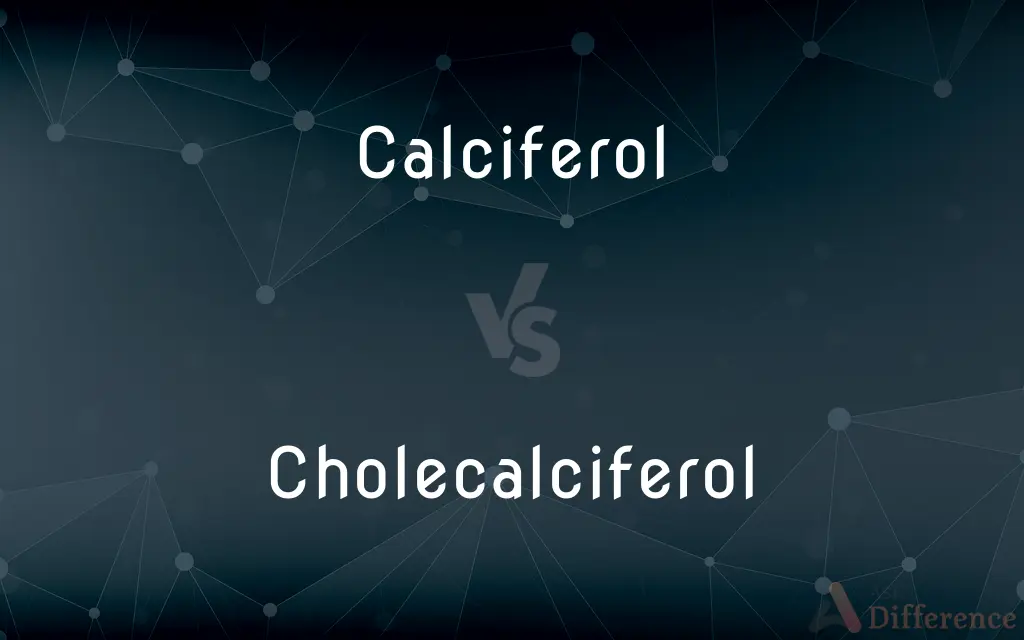Calciferol vs. Cholecalciferol — What's the Difference?
Edited by Tayyaba Rehman — By Fiza Rafique — Published on February 21, 2024
Calciferol generally refers to Vitamin D, while Cholecalciferol specifically denotes Vitamin D3, one of the two primary forms of Vitamin D, the other being ergocalciferol (Vitamin D2).

Difference Between Calciferol and Cholecalciferol
Table of Contents
ADVERTISEMENT
Key Differences
Calciferol is a term often used interchangeably with Vitamin D, encompassing both primary forms of this essential nutrient: cholecalciferol (Vitamin D3) and ergocalciferol (Vitamin D2). Vitamin D is crucial for various bodily functions, including calcium absorption, bone health, and immune system support.
Cholecalciferol, or Vitamin D3, is naturally synthesized in the skin upon exposure to sunlight (specifically UVB radiation) and can also be obtained from certain animal-based foods or supplements. It is generally considered more effective than ergocalciferol (Vitamin D2) in raising and maintaining Vitamin D levels in the blood over time. This is partly because cholecalciferol is the form of Vitamin D produced naturally by the body when the skin is exposed to sunlight.
The distinction between calciferol and cholecalciferol lies mainly in the scope of their definitions. Calciferol encompasses the broader category of Vitamin D compounds, including both D2 and D3 forms, whereas cholecalciferol refers specifically to the D3 form. This specificity is important in nutritional science and medicine, as the two forms of Vitamin D can come from different sources and may have slightly different effects on the body.
In the context of dietary supplements and fortification, cholecalciferol is often favored due to its potency and the body's natural inclination to this form. Understanding the difference between these terms is crucial for accurate communication about Vitamin D's dietary sources, supplementation, and its role in health.
Comparison Chart
Forms
Includes Vitamin D2 (ergocalciferol) and D3 (cholecalciferol)
Specifically refers to Vitamin D3
ADVERTISEMENT
Sources
D2 from plant sources and UV-exposed fungi; D3 from sunlight and animal sources
Synthesized in skin through sunlight; also found in fatty fish, liver, and egg yolks
Potency
Vitamin D3 is generally more potent and effective in raising blood Vitamin D levels than D2
Considered more effective in maintaining adequate Vitamin D levels in the body
Function
Essential for calcium absorption, bone health, and immune function
Same as calciferol, with a specific emphasis on the form produced naturally by the body
Use in Supplements
Both D2 and D3 forms may be used, but D3 is preferred for its efficacy
Widely used in supplements and fortified foods due to its effectiveness
Compare with Definitions
Calciferol
Encompasses both Vitamin D2 and D3 forms.
Plant-based milk alternatives are often fortified with Vitamin D2 for bone health.
Cholecalciferol
More potent than D2 in raising blood Vitamin D levels.
Cholecalciferol supplements are effective for correcting Vitamin D deficiency.
Calciferol
Obtained from sunlight, food, and supplements.
Regular sun exposure is a natural way to maintain adequate Vitamin D levels.
Cholecalciferol
The natural form of Vitamin D produced by the skin.
Sunbathing enables the synthesis of cholecalciferol in the skin.
Calciferol
An essential nutrient important for bone health and calcium absorption.
Vitamin D fortified milk helps prevent osteoporosis.
Cholecalciferol
Essential for bone health and calcium metabolism.
Cholecalciferol plays a key role in maintaining bone density and strength.
Calciferol
Supports immune system and muscle function.
Adequate Vitamin D intake is crucial during the winter months to support immune health.
Cholecalciferol
Preferred form for supplementation due to efficacy.
Most over-the-counter Vitamin D supplements contain cholecalciferol.
Calciferol
Deficiency linked to various health issues.
Vitamin D deficiency can lead to rickets in children and osteomalacia in adults.
Cholecalciferol
Found in animal-based foods and supplements.
Fatty fish like salmon is a rich source of cholecalciferol.
Calciferol
One of the forms of vitamin D, a fat-soluble vitamin that prevents rickets. It is an unsaturated alcohol, C28H43OH found in foods such as milk and fish liver oils. It is used as a dietary supplement in milk.
Cholecalciferol
Vitamin D3
Common Curiosities
What is Calciferol?
Calciferol broadly refers to Vitamin D, including both Vitamin D2 (ergocalciferol) and Vitamin D3 (cholecalciferol).
What is Cholecalciferol?
Cholecalciferol is specifically Vitamin D3, the form of Vitamin D synthesized in the skin through sun exposure and found in certain animal-based foods.
Which is more effective for supplementation, Calciferol or Cholecalciferol?
Cholecalciferol (Vitamin D3) is generally considered more effective for supplementation due to its higher potency in raising blood Vitamin D levels.
How do Calciferol and Cholecalciferol differ in sources?
Calciferol sources include both plant-based (D2) and animal-based (D3) foods, while cholecalciferol is primarily obtained from sun exposure and animal sources.
Can both Calciferol and Cholecalciferol prevent Vitamin D deficiency?
Yes, both forms can prevent Vitamin D deficiency, but cholecalciferol (D3) is often preferred for its greater efficacy.
What role does Calciferol play in bone health?
Calciferol is crucial for calcium absorption and regulation, directly impacting bone density and health.
What are the recommended daily amounts of Calciferol?
The recommended daily amounts of Vitamin D (Calciferol) vary by age, health status, and exposure to sunlight but generally range from 400 IU (Infants) to 800 IU (Adults over 70).
Why is Cholecalciferol preferred over Ergocalciferol in supplements?
Cholecalciferol is preferred because it is more effective in maintaining adequate Vitamin D levels in the body and is the natural form produced by the skin.
Are there any health risks associated with high intake of Cholecalciferol?
Excessive intake of cholecalciferol can lead to Vitamin D toxicity, characterized by hypercalcemia and other health issues.
What is the role of Calciferol in muscle function?
Calciferol is vital for muscle function, contributing to muscle strength and coordination, and preventing muscle weakness and falls, especially in older adults.
How does sun exposure contribute to Cholecalciferol production?
UVB radiation from sunlight triggers the synthesis of cholecalciferol in the skin, converting a cholesterol precursor into Vitamin D3.
Can dietary intake alone meet Vitamin D (Calciferol) requirements?
For most people, dietary intake alone may not meet Vitamin D requirements, especially in areas with limited sunlight, making supplementation necessary.
How does Vitamin D3 (Cholecalciferol) support the immune system?
Vitamin D3 modulates the immune system, enhancing innate immunity and regulating adaptive immunity, potentially reducing the risk of infections and autoimmune diseases.
How is Vitamin D deficiency diagnosed and treated?
Vitamin D deficiency is diagnosed through blood tests measuring 25-hydroxyvitamin D levels and is commonly treated with cholecalciferol supplementation.
What factors can affect Cholecalciferol synthesis from sunlight?
Factors include geographic latitude, season, time of day, skin pigmentation, age, and sunscreen use, all of which can reduce UVB exposure and Vitamin D3 synthesis.
How is Cholecalciferol absorbed and metabolized in the body?
Cholecalciferol is absorbed through the intestines and then undergoes two hydroxylation steps, in the liver and kidneys, to become the active form of Vitamin D, calcitriol.
Are there any interactions between Calciferol and medications?
Yes, Calciferol can interact with certain medications, such as steroids, weight loss drugs, and epilepsy medications, affecting Vitamin D metabolism.
Can Calciferol levels affect mood and mental health?
Emerging research suggests a link between Vitamin D levels and mood, with deficiencies associated with an increased risk of depression and mood disorders.
What are the signs of Cholecalciferol overdose?
Signs of overdose include nausea, vomiting, weakness, frequent urination, and serious complications like kidney damage due to hypercalcemia.
Share Your Discovery

Previous Comparison
Cuvette vs. Test Tube
Next Comparison
SDS Page vs. Native PageAuthor Spotlight
Written by
Fiza RafiqueFiza Rafique is a skilled content writer at AskDifference.com, where she meticulously refines and enhances written pieces. Drawing from her vast editorial expertise, Fiza ensures clarity, accuracy, and precision in every article. Passionate about language, she continually seeks to elevate the quality of content for readers worldwide.
Edited by
Tayyaba RehmanTayyaba Rehman is a distinguished writer, currently serving as a primary contributor to askdifference.com. As a researcher in semantics and etymology, Tayyaba's passion for the complexity of languages and their distinctions has found a perfect home on the platform. Tayyaba delves into the intricacies of language, distinguishing between commonly confused words and phrases, thereby providing clarity for readers worldwide.
















































